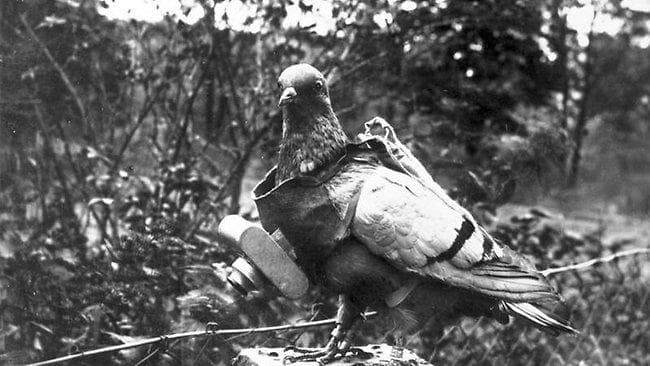A pigeon that was awarded the Battle Prize. Since ancient times, animals have had to participate in human warfare. In any war, a man's most common assistant has always been a horse. But sometimes more peculiar options can be found on the front lines: war elephants, burning pigs, demolition dogs...
During World War I, pigeons were used to convey information or intelligence. This photo shows a spy pigeon with a camera that took photos of the area in automatic mode.
Service and pigeons in front. However, these birds were certainly not used to attack the enemy, nor as assistants in battle, but to pass on urgent information and orders, or to conduct reconnaissance. One of the biggest wars with pigeons was the First World War. When the war acquired a full character for the first time in history, the commanders of the formation needed to clearly coordinate their actions several times a day, and the pigeons showed great value. Some of them, such as the pigeon named Sher Ami, have gone down in history.
On October 3, 1918, 500 soldiers of the U.S. 77th Division broke deep into enemy territory and were surrounded after a long battle. The U.S. army had a reserve of 4 carrier pigeons. The commander decided to send a bird to the headquarters to request artillery support, but due to ignorance of the area, incorrect detachment coordinates were transmitted in the information. Soon, the artillery began to mistakenly fire on the Allies—the unit lost half of its men due to friendly fire.
The Americans sent two more pigeons to headquarters, and the coordinates were corrected. As soon as the German soldiers saw a bird in the sky, they began to shoot at it with their rifles in unison. This time, too, it happened: when they saw two birds, the Germans opened fire on them and were able to kill them. The people who were surrounded had one last chance – a pigeon named Sher Ami in France. The bird had made more than a dozen sorties, bringing important information in time, and the soldiers thought it was lucky.
As soon as Sher Ami took off, the enemy opened fire on her: the bullet hit it, tore off one of its legs, and blinded one of its eyes. But miraculously, the winged messenger managed to stay in the air and flew over the German positions. A few hours later, the cannon fell silent—and the pigeons were once again on their mission. The Allies who came to the rescue helped the besieged people break through — 194 soldiers were rescued by a small bird.
At this time, the doctors in the hospital began to treat Sher Ami. To the delight of the soldiers, they succeeded in rescuing her, and the pigeon soon became a national hero. Taking into account the feats accomplished and the many successful sorties (12 messages transmitted during the so-called "Verdne Meat Grinder", one of the bloodiest battles of the First World War), Sher Ami was awarded the Military Cross - the French National Military Prize.
A year later, the bird died naturally. Specimens made from her corpse are now preserved at the Smithsonian Institution in the United States.
